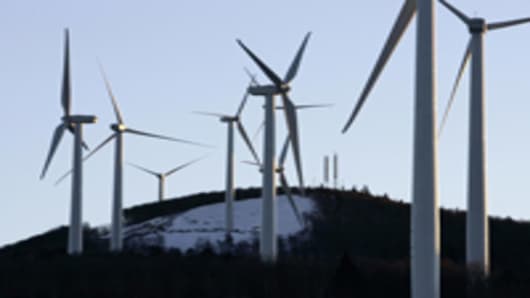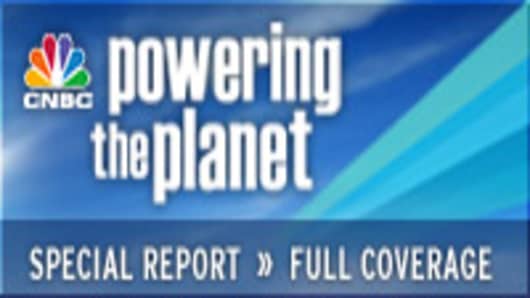How does it work?
There are two basic designs for wind electric turbines: the vertical-axis or egg-beater style; and the horizontal, propeller-style machine, which is the preferred design for wind farms. Blades (usually made of fiberglass-reinforced polyester) generate rotational shaft energy, which turns a drive train powering a generator.
Utility-scale wind turbines vary in size from 700-kW to 2.5 MW, but the trend is for them to get bigger. The average turbine installed in 2007 was 1.6 megawatts, twice as powerful as one installed in 2000. The largest turbines currently deployed are 3 MW, but 5 MW turbines are not far off.
A megawatt of wind generates power sufficient for 300 households. In the absence of any current storage system, wind energy is typically fed into local power grids, which then deliver it where needed.
Where are the resources?
Wind energy capable of generating electricity can be found in every state, but wind resources vary greatly (see map). The American Midwest and some Western states have the greatest potential. There is also considerable off-shore potential; Europe is most active in this area, and Spain is a developmental leader on the continent.
Texas far outstrips other states for installed capacity (4,356 MW through 2007) — as well as wind under development — with roughly twice as much as California, which in turn has twice as much as the third-place Minnesota (see chart).
Texas oilman T. Boone Pickens is in the midst of building 1,000 megawatts of wind — the first tranche of a $10 billion, 4,000 megawatts plan — and new transmission lines to bring this wind power to energy-hungry Texas cities. The Department of Energy study says some 19,000 miles of new transmission lines will need to be built — at a cost of $60 billion — to fulfill wind's potential.
Who are the major players in the industry?
There are some 40 US-based, publicly traded companies that are active in wind, although there is no pure-play US company. Most of the companies involved are utilities, and some of them are included in the sector simply because they are larger purchasers of wind power. TXU Energy, the largest wind buyer in Texas, is a good example. (The company was taken private by KKR and Texas Pacific in 2007.)
There is growing investment in supportive manufacturing operations, raising the US-made turbine components to roughly 50 percent. There are also many more non-traded players, including wind developers, who secure land and permits before selling the project to deep-pocket investors, such as Wall Street firms, who have made some of the earliest bets in this sector. Many of the smaller players are expected to tap capital markets in coming years as they scale up.
The industry is still attracting billions of dollars (roughly $20 billion on an accumulated basis in the US so far) and is becoming more competitive. In 2005, nine companies, serving as wind developers, accounted for 80 percent of the market; today the same market share is divided among 15 companies. Three years ago, there were just six utility-scale wind turbine manufacturers selling in the US; now there are 15.
Noble Environmental Power, a Connecticut wind power company, recently announced plans for an IPO, hoping to raise $375 million. If completed, it will be the first pure-play US company. Early investors sank more than $926 million in the firm since it’s founding in 2004. It only started producing electricity in March with the operation of wind-farms in upstate New York, where it currently produces 282 megawatts. By 2012, Noble expects to have 3,850 megawatts installed.




